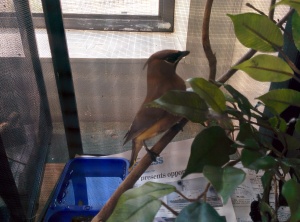By Michele Wellard, Assistant Wildlife Rehabilitator
The woman who brought the waxwing in said he seemed “tame.” He just sat on her finger and wouldn’t move, and that’s what prompted her to call the clinic. She was convinced the bird had been raised by humans. When she brought him to me, perched on her finger, I thought he had a sort of ‘faraway’ look about him – like he wasn’t entirely present. There was just sort of an odd affect about him. Additionally, he also was in absolutely PERFECT feather, and he was in great body condition – upon palpating his breast muscle I could feel that he was almost fat, suggesting he’s been having no trouble finding winter berries, and maybe even overindulged a bit. This was a healthy looking bird.
His odd behavior continued the rest of the day and into the next – this dreamy look, like he was a million miles away in his head. Having read many times about this species’ proclivity for drunkenness, I looked up videos of drunk waxwings on youtube, and those depicted behaved just like this one – just being very still and being able to be handled easily. You might be surprised to learn that this is common. Since these birds are huge berry eaters, and some berries at this time in the year have fermented as they sit on the bush, drunk waxwings are an interesting occurrence.
 These symptoms are also connected with head trauma in wild birds, so that was also a possibility. But given his behavior, we didn’t think that was the case. He was much, much more ‘still’ than other concussed birds I’ve treated, and there was just something odd about the way he looked. Sure enough, after two days in the ‘drunk tank’ – after some anti-inflammatories, lots of fluids, and lots of free berries and worms from us, he started acting like a wild bird, completely scared of us and fluttering around and flying just like a normal wild bird. Sometimes birds like this fly into windows, or get stepped on, so he could have really been injured. I’m glad the woman was concerned enough to bring him to us.
These symptoms are also connected with head trauma in wild birds, so that was also a possibility. But given his behavior, we didn’t think that was the case. He was much, much more ‘still’ than other concussed birds I’ve treated, and there was just something odd about the way he looked. Sure enough, after two days in the ‘drunk tank’ – after some anti-inflammatories, lots of fluids, and lots of free berries and worms from us, he started acting like a wild bird, completely scared of us and fluttering around and flying just like a normal wild bird. Sometimes birds like this fly into windows, or get stepped on, so he could have really been injured. I’m glad the woman was concerned enough to bring him to us.
Here we are releasing him:
Update, December 11, 2014, on where the waxwing was released:
During the winter, waxwings spend all their time in large flocks, but this one was found all alone. Therefore, we could not find his original flock. Also, he was found in the city, with no nearby source of food. We didn’t know where he had come from before he fell to the ground. So, we had to decide where to let him go where he had the best chance of finding 1) appropriate food (berries) and 2.) other Waxwings. To do this, we looked on the e-bird website, where bird watchers report up-to-the-minute bird sightings. According to e-bird, the most recent sighting of a large flock of waxwings in the Philadelphia area was the day before the release, in Houston Meadow, which also happens to have many plants and bushes with berries still on them. So we decided that was the waxwing’s best chance of finding food and flockmates.
